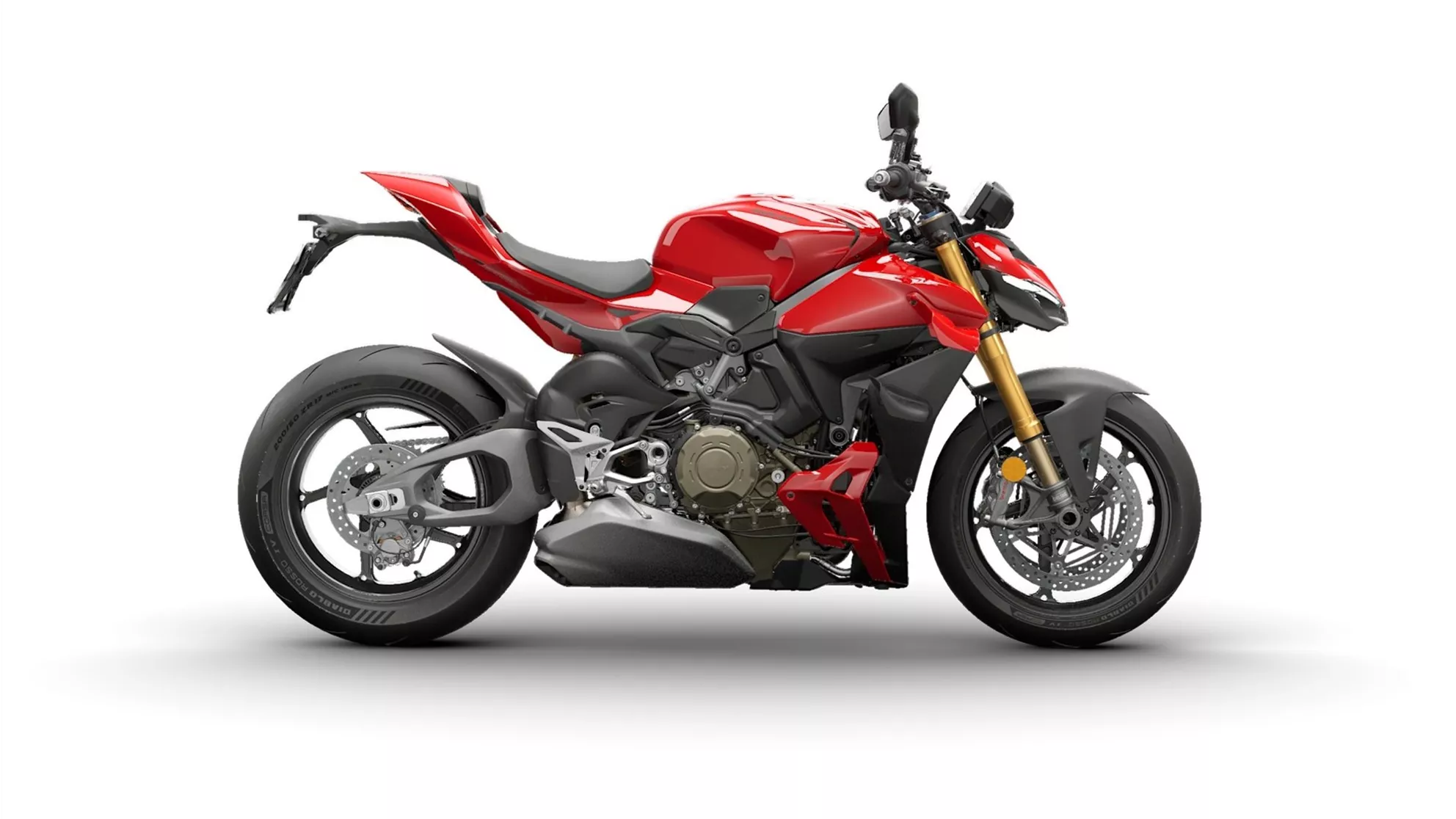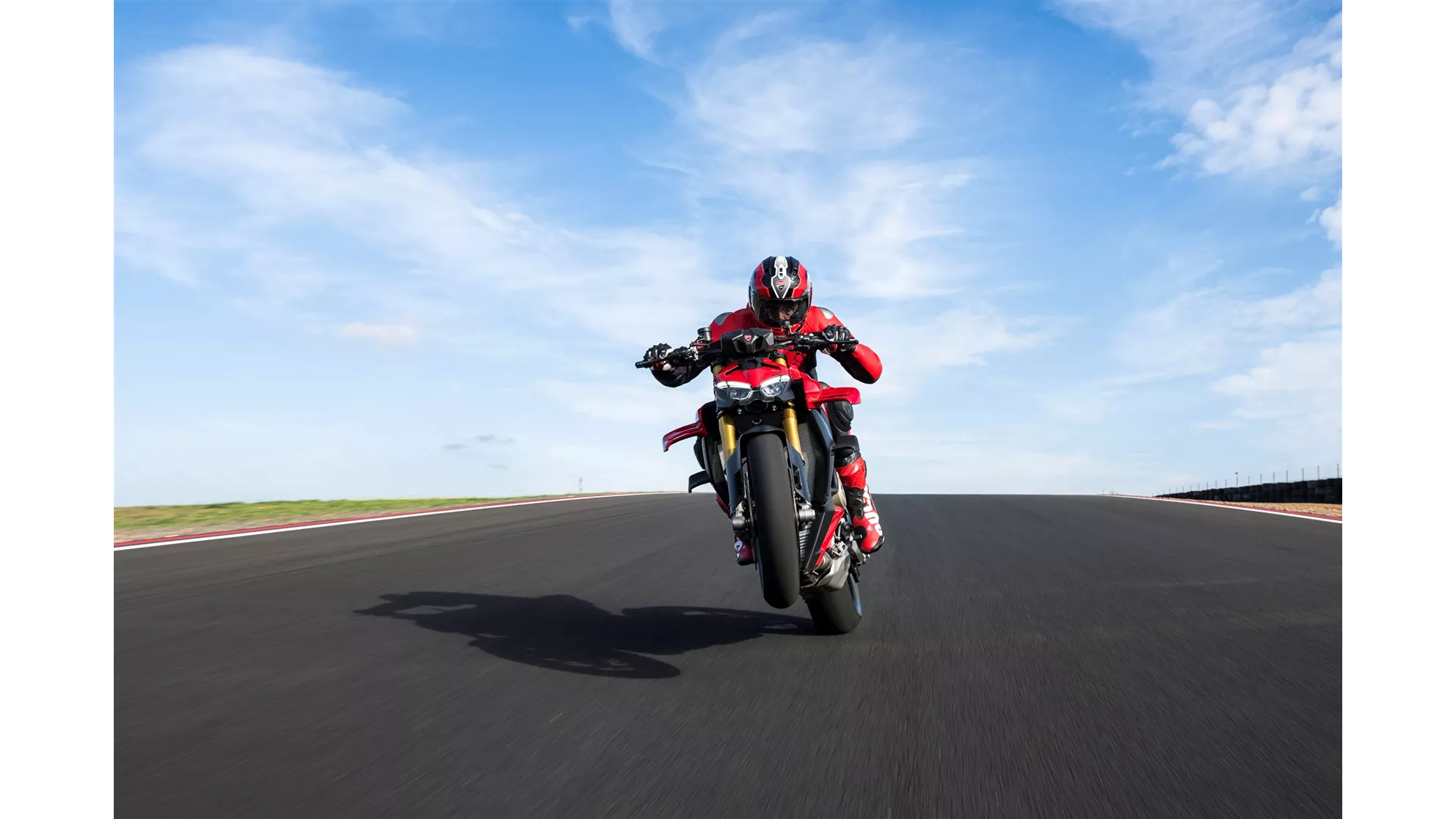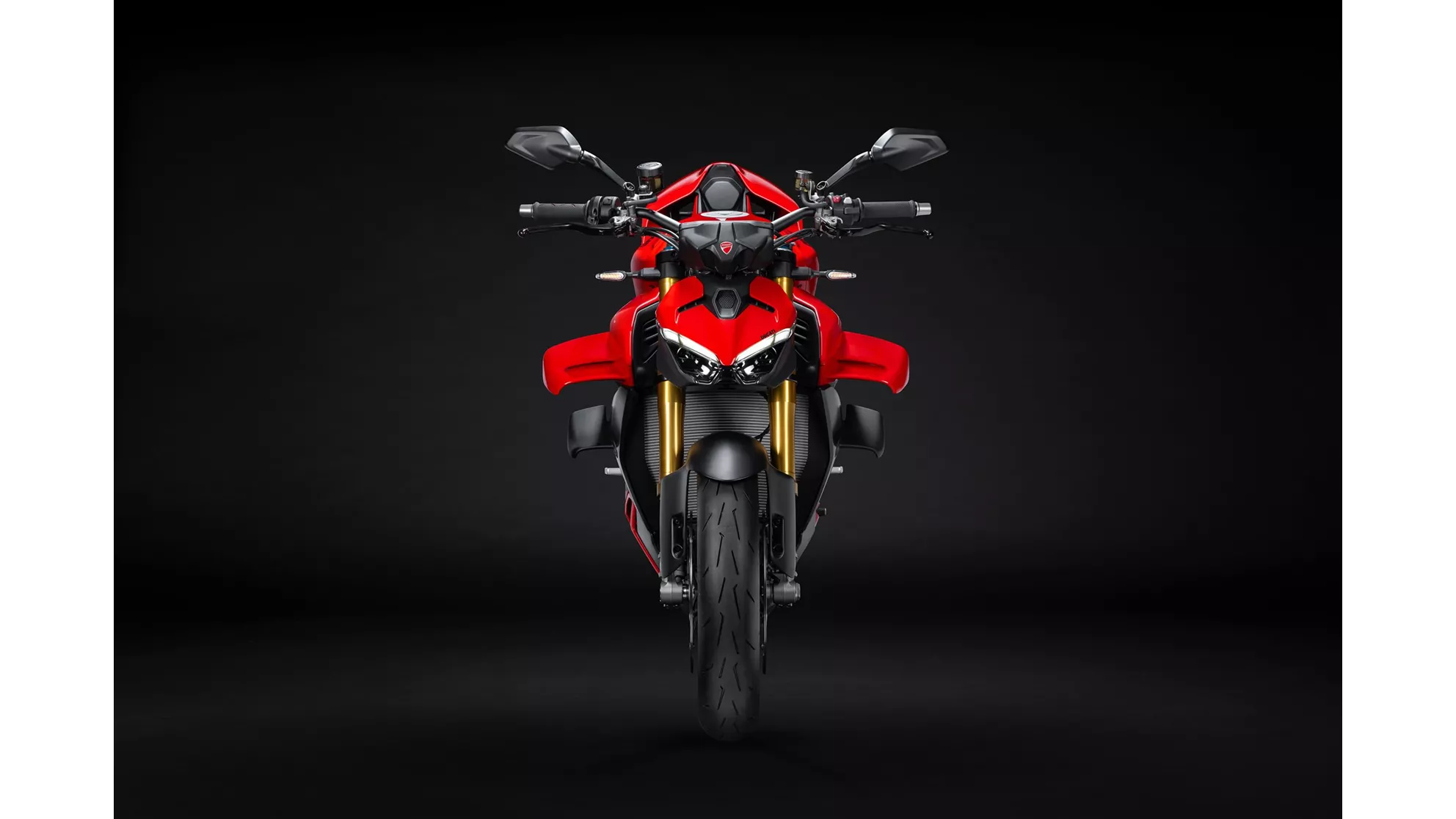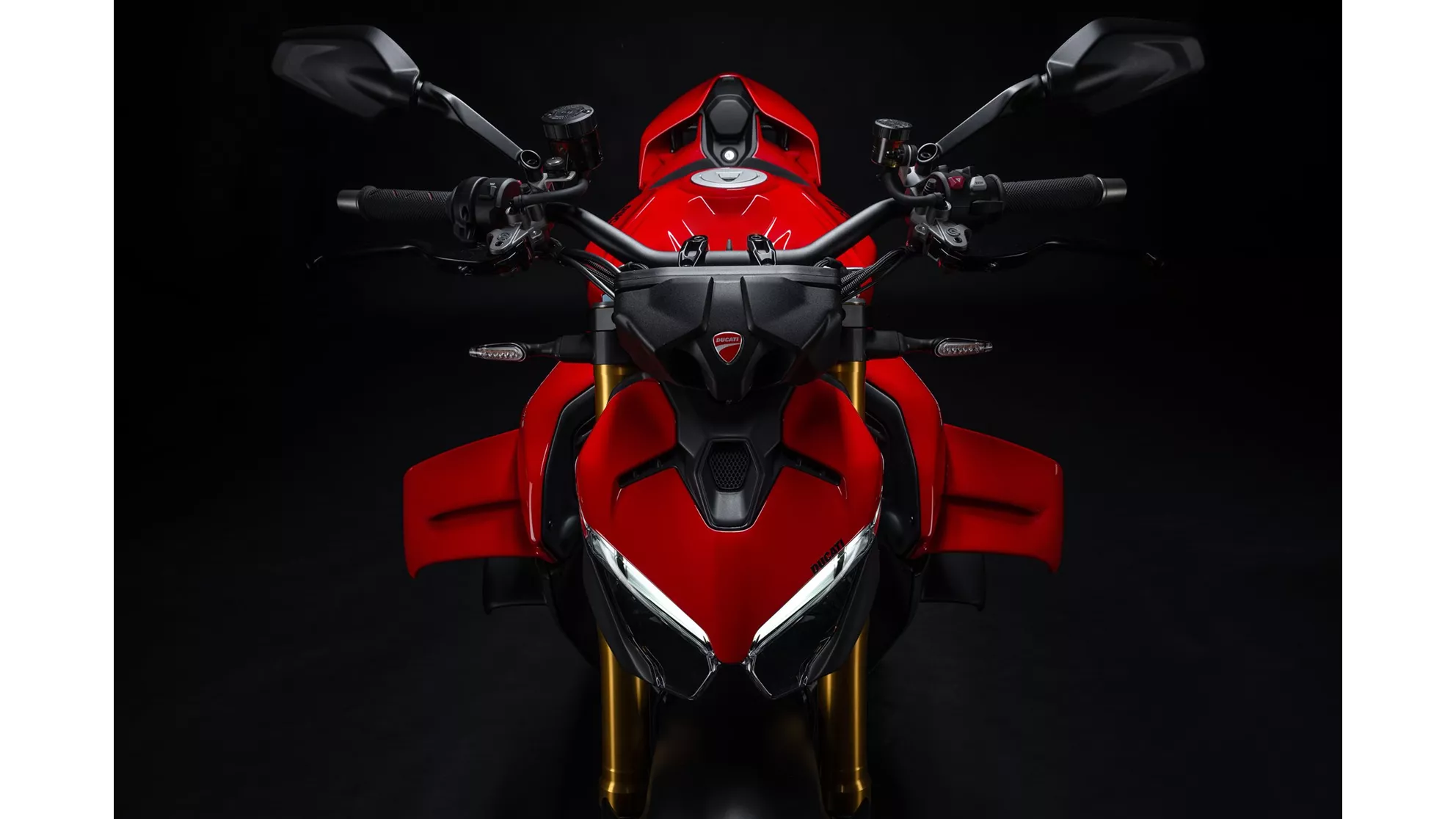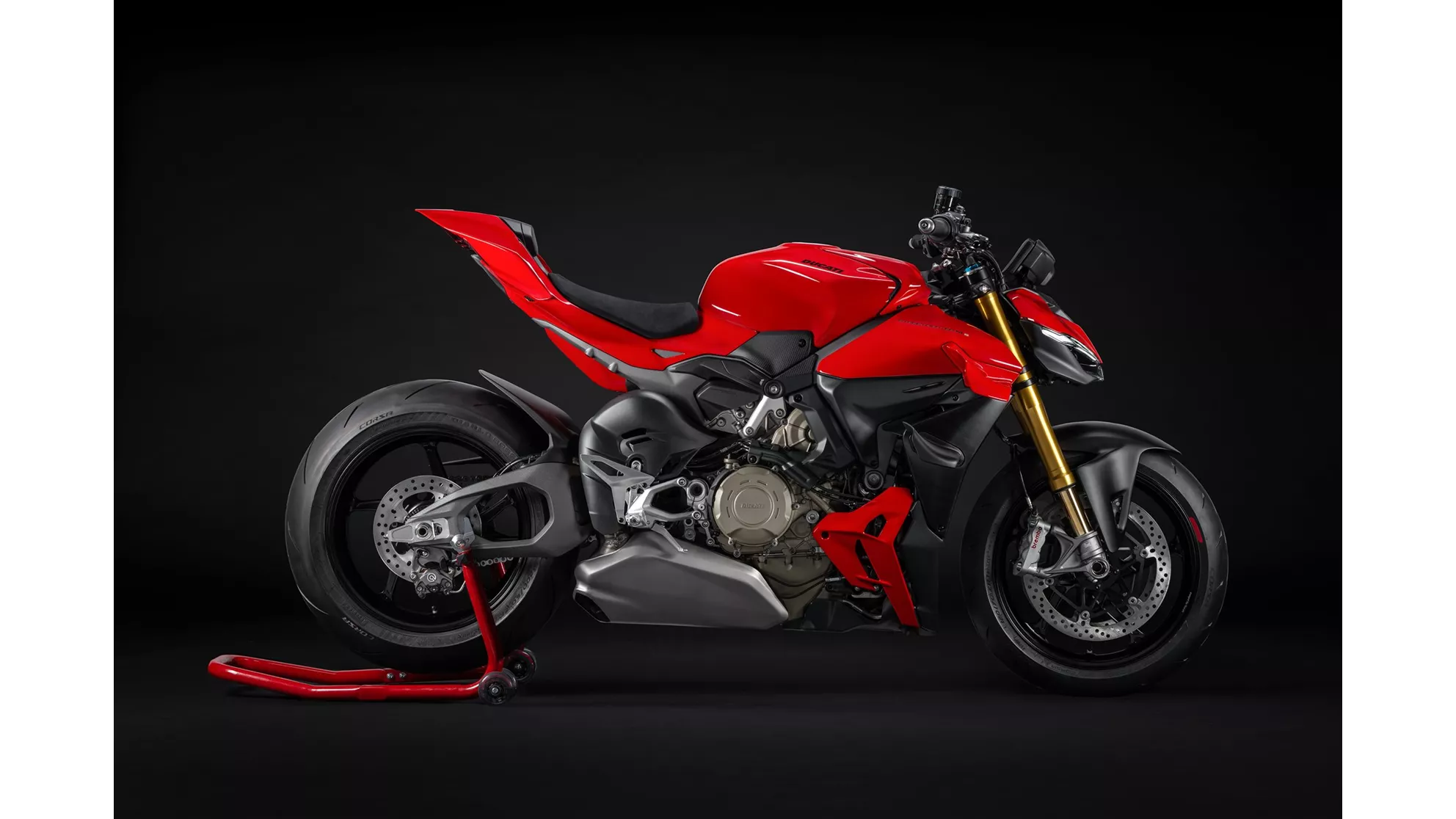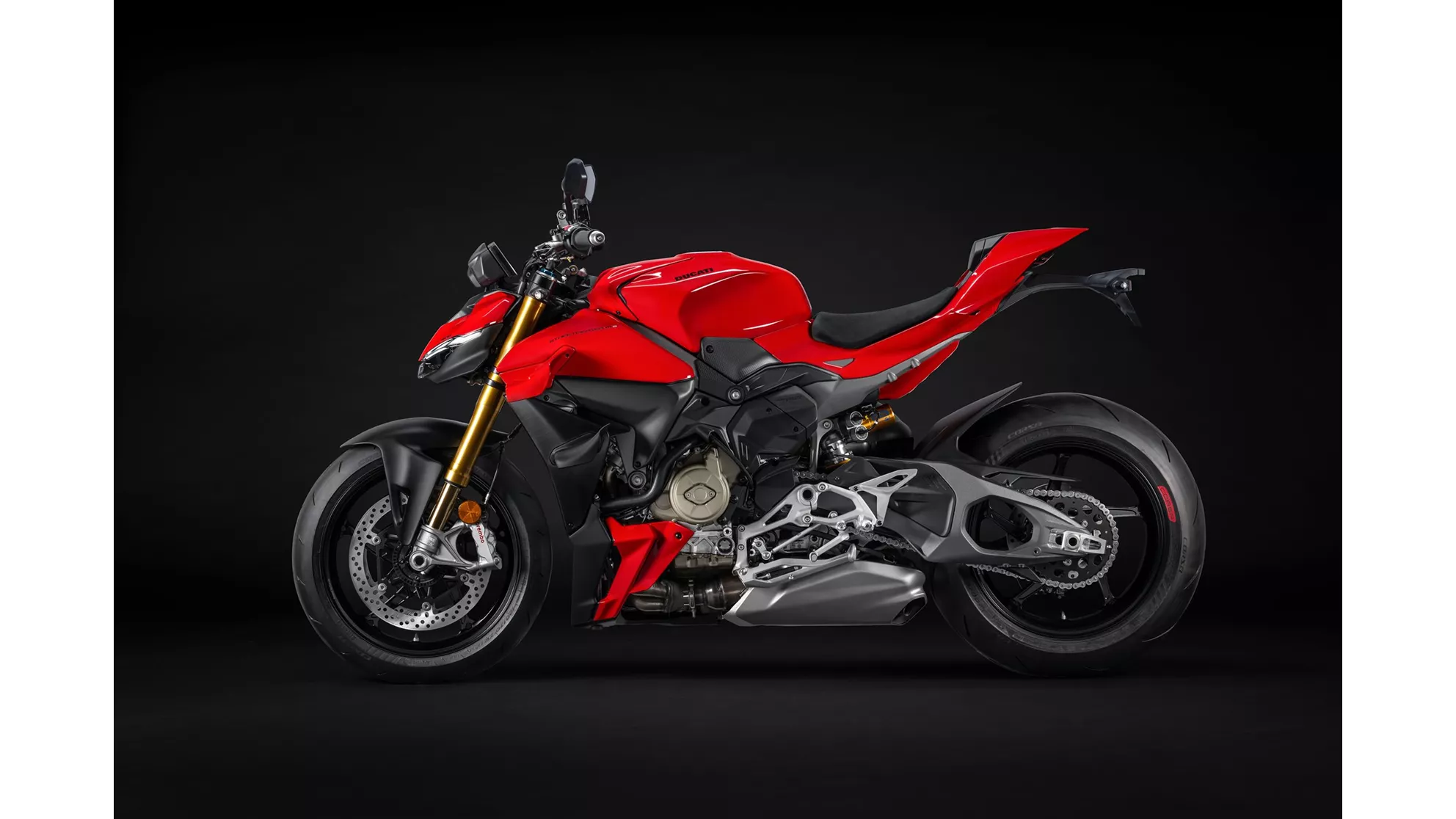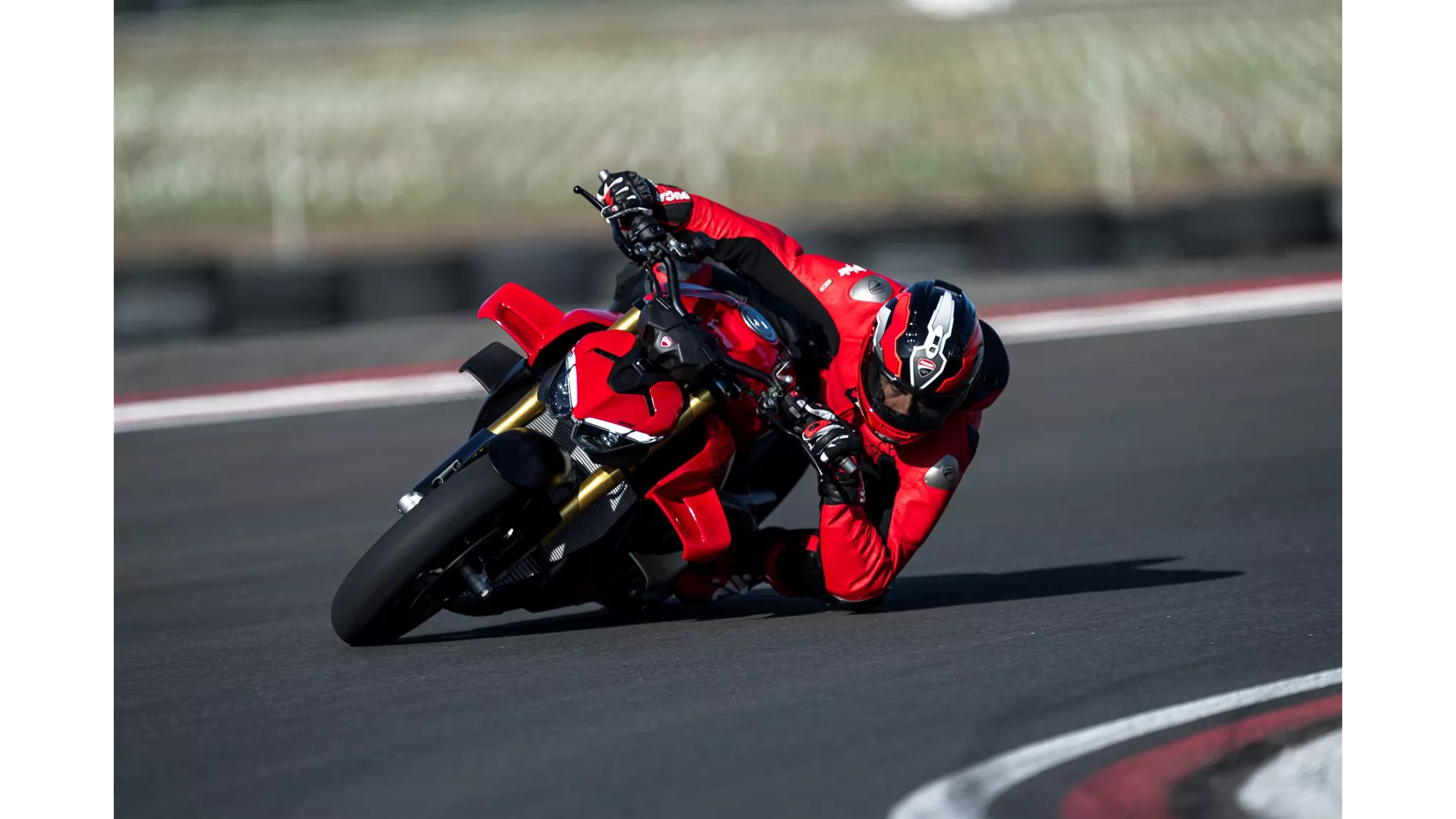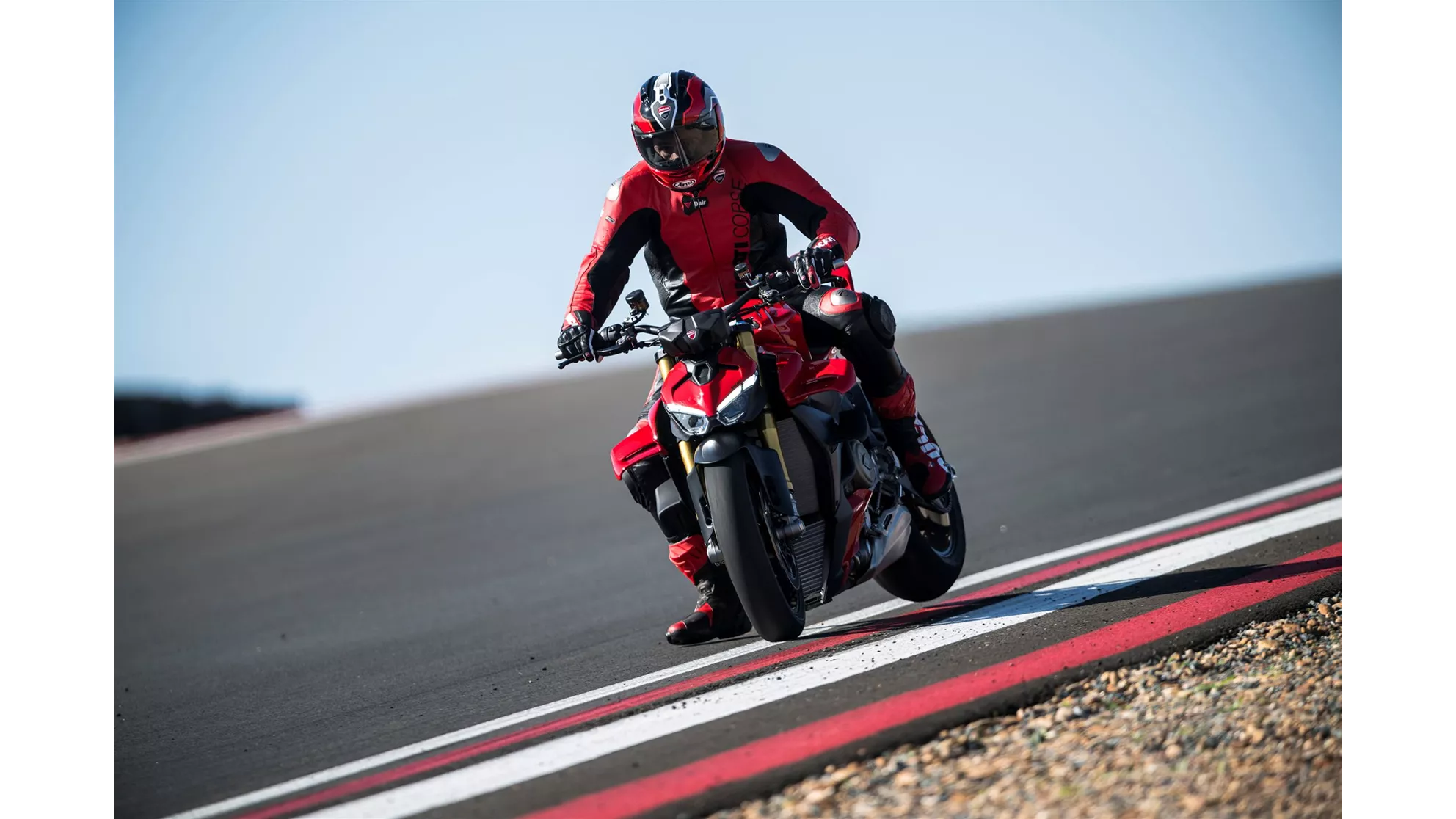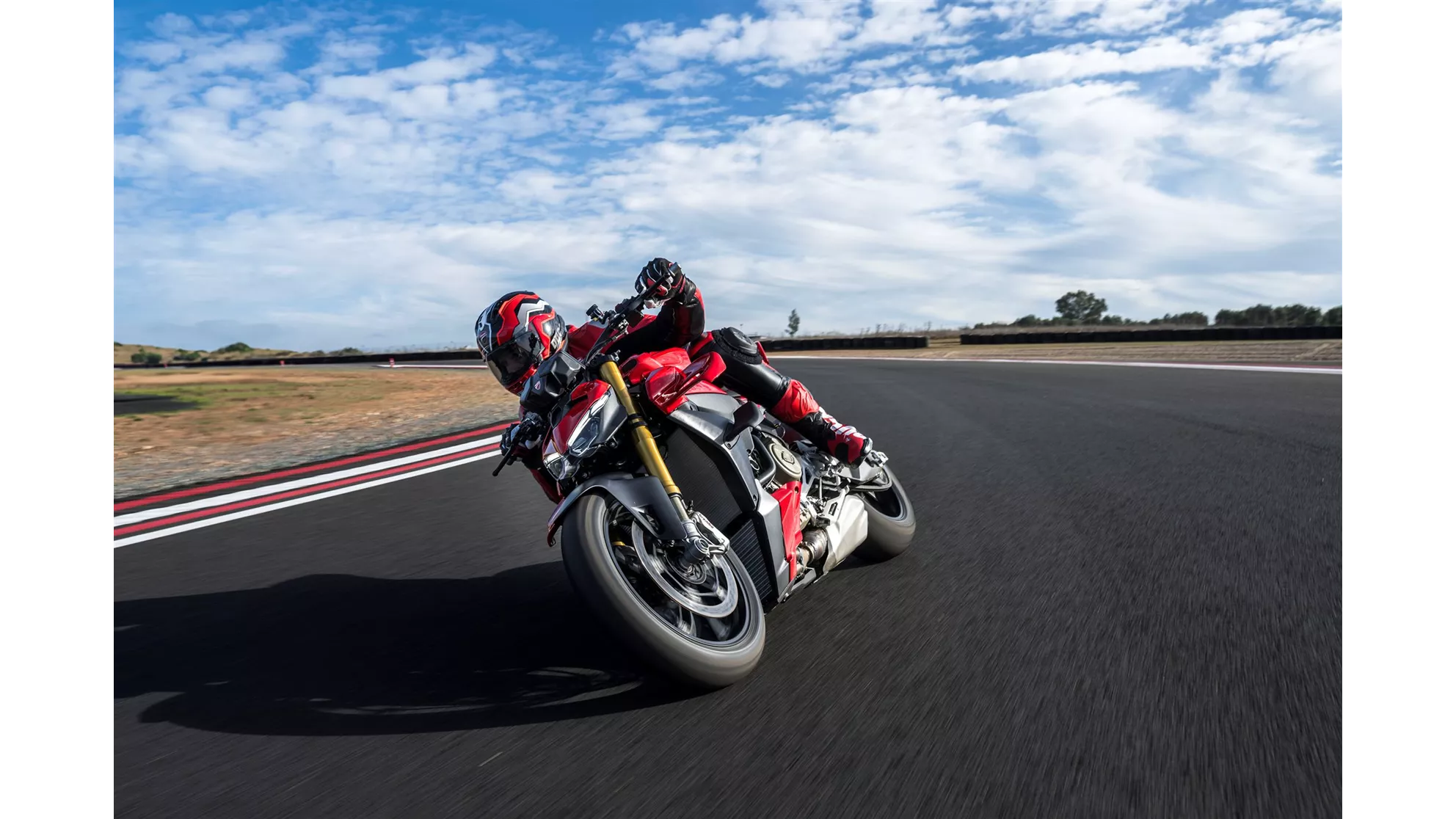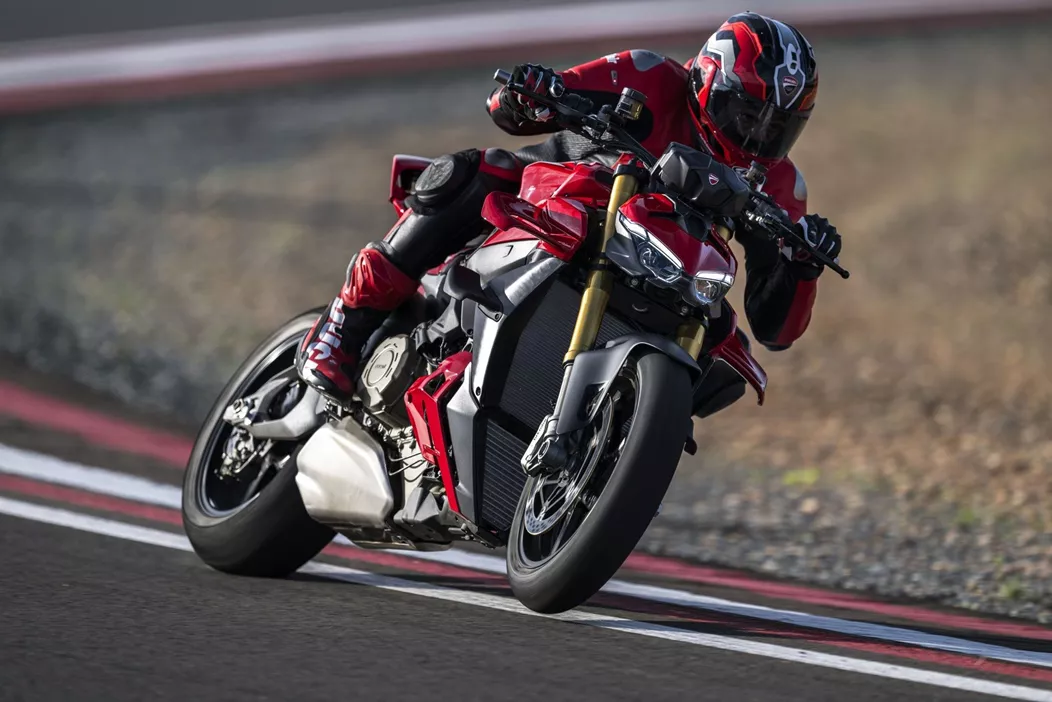With increased power, reduced weight, and cutting-edge electronics, it achieves an impressive power-to-weight ratio of 1.13 hp/kg, unmatched in its class. With its MotoGP DNA, it combines track performance with remarkable everyday usability.

Ducati Streetfighter V4 2025 Review
The Evolution of the Fight Formula
With the new Streetfighter V4, Ducati unveils a naked bike that sets new standards in performance, technology, and design. Now more closely aligned with the Panigale V4 than ever, the Streetfighter borrows its engine, chassis, electronics, and numerous technical updates directly from the superbike.
&width=72&height=72&bgcolor=rgba_39_42_44_0&mode=crop)
Martin_Bauer
published on 31/03/2025
Engine – A High-Performance V4 with Racing DNA
The engine of the new Ducati Streetfighter V4 is the renowned Desmosedici Stradale V4 with a displacement of 1,103 cc, now delivering 214 hp at 13,500 rpm and a maximum torque of 120 Nm at 11,250 rpm. Ducati has further refined the engine for the 2025 model, equipping it with new camshafts to optimize power output. The revised intake with variable funnels ensures an even better balance between peak performance and rideability.
Despite the Euro5+ standards, Ducati has preserved the powerful and distinctive sound of the V4 engine. For riders looking to extract maximum performance, Ducati offers an Akrapovič racing exhaust system that reduces weight and boosts power to 226 hp.
Chassis – Lighter and More Stable
The Ducati Streetfighter V4 benefits from a revised chassis directly inherited from the Panigale V4. The new aluminum front frame is not only 950 grams lighter but also features a 39% reduction in lateral stiffness, intended to enhance cornering handling. The brand-new hollow-bored symmetrical double-sided swingarm is another technical masterpiece. It is not only 3.27 kilograms lighter than the previous single-sided swingarm with linkage but also offers 37% less lateral stiffness, which is expected to improve traction at corner exits and optimize acceleration.
Additionally, small but crucial changes have been made to the geometry. The steering head angle has been increased by 0.5 degrees and the trail extended by 1 millimeter to further enhance stability.
Suspension – Cutting-Edge Technology for Road and Track
Ducati has further refined the suspension of the Streetfighter V4, offering different solutions depending on the model. While the standard version features a fully adjustable Showa Big Piston Fork (BPF) with a 43 mm stanchion and a Sachs shock absorber, the Streetfighter V4 S comes equipped with a high-tech Öhlins suspension.
The S version features an electronically controlled NIX 25/30 (SV) S-EC 3.0 fork and a TTX36 (SV) S-EC 3.0 shock. This suspension utilizes the Öhlins Smart EC 3.0 system, which automatically adapts to riding style and track conditions. A unique feature is the new "Cruise Detection" function, which softens the damping at constant speeds, significantly enhancing ride comfort on longer journeys.
Brakes – Ultimate Precision and Maximum Control
The braking system of the 2025 Ducati Streetfighter V4 has been further developed to provide maximum control both on the road and on the track. Up front, it features two 330-mm discs with the latest Brembo Hypure® monoblock calipers, which are not only lighter compared to the previous model but also dissipate braking heat more effectively. At the rear, a 245-mm disc with a 2-piston caliper ensures the necessary stopping power.
The new Race eCBS system further optimizes braking performance and includes a Slide-by-Brake function, which allows controlled drifting while enhancing ride stability.
Electronics – MotoGP Technology for the Road
The new Ducati Streetfighter V4 is equipped with state-of-the-art electronics derived from MotoGP. The new Ducati Vehicle Observer (DVO) simulates over 70 sensors to control all electronic systems with even greater precision. This system is complemented by an enhanced traction control, the eight-level adjustable Ducati Traction Control (DTC) DVO, a refined Ducati Slide Control (DSC), and a new Ducati Wheelie Control (DWC) DVO.
The new Ducati Quick Shift (DQS) 2.0 technology enables especially precise gear changes by eliminating the micro-switch and instead using an angle position sensor, making the shifting feel even more direct.
Riding Modes – Adaptable for Every Riding Situation
As with the Panigale V4, riders can choose from four riding modes:
In Race mode, the bike unleashes its maximum performance for the track. The Sport mode offers dynamic tuning for winding country roads, while the Road mode optimizes the bike for everyday use. The new Wet mode enhances safety on wet surfaces and reduces torque for smoother power delivery. Additionally, there are four Power Modes (Full, High, Medium, Low) available to adjust the engine's responsiveness.
Ergonomics – Enhanced Control and Comfort
Ducati has further improved the ergonomics. The handlebars have been moved 10 mm closer to the rider, which is intended to ease control in corners. Simultaneously, the foot pegs have been positioned 10 mm further inward, lower, and more forward to allow for greater lean angle clearance. The tank-seat unit provides more freedom of movement and better anchoring, enabling less fatiguing riding during deceleration and hanging off in corners, while new air channels ensure hot air is more efficiently directed away from the rider.
Features – High-Tech on Two Wheels
The new 6.9-inch TFT display with an 8:3 aspect ratio ensures improved readability and offers various views for road and track. Optionally, "Turn by Turn" navigation and the Ducati Multimedia System (DMS) for smartphone connectivity can be added.
Design and Aerodynamics – More Aggressive, More Functional
The new Ducati Streetfighter V4 stays true to the aggressive Ducati DNA while presenting an even more modern look. The new LED headlight enhances the striking appearance, while the rear with its "Double-C" LED taillight adds another visual highlight. The new biplane winglets generate 17 kg of downforce at 270 km/h, further improving handling at high speeds.
Differences Between Streetfighter V4 and V4 S
In addition to the previously mentioned suspension difference, the V4 S features forged aluminum wheels instead of cast ones, as well as a lighter lithium-ion battery, resulting in a total weight savings of 2 kg.
The new Ducati Streetfighter V4 will be available from March 2025. The standard version is priced at €30,795 in Austria, while the S version with the Öhlins Smart EC 3.0 suspension is priced at €34,995.
Riding Impression
Even though the new V4 Streetfighter is heavily based on the Panigale, it isn't straightforward to transfer the superbike's riding characteristics. Factors like the wide handlebars, upright seating position, and lack of wind protection create a completely different dynamic compared to the supersport category. However, the adjustments made in comparison to the Panigale hit the mark. What impresses most is the extremely stable ride, even at very high speeds. There aren't many naked bikes that can run straight and steady beyond 250 km/h. The new frame construction and swingarm, with significantly more flex, contribute massively to stabilizing the bike around the yaw axis. The slightly shallower steering head angle and longer wheelbase create a certain supersport feeling, even on the naked bike. Only the wind pressure at top speed reminds you of the lack of fairing. Notably, there are no turbulences affecting the helmet or torso, allowing for an unobstructed visual perception. Only the slightly strained neck muscles remind you of the brisk pace and the opposing windstorm. The new electronic Öhlins suspension 3.0, with new valves and software, also contributes to stability. Despite the 214 hp, you can fully throttle out of corners even when leaned over, without inducing much movement. This allows for very tight corner exits despite massive acceleration. The grip is exceptionally high, close to superbike levels. Additionally, the suspension offers a wide range of adjustments, providing plenty of comfort for road riding alongside occasional track use. In automatic mode, the "cruising" on straight roads is detected, and the damping settings are autonomously adjusted, resulting in a very comfortable ride as long as extreme lean angles are not taken.
The now shorter gearing helps keep the engine in an engaging rev range, particularly on country roads. Despite the high power, the engine needs at least 5,000 rpm to really get going. If you want serious thrust, you'll need to hit 9,000 rpm. At that point, the V4 pushes so powerfully that in the first two gears, full power is hardly manageable. Thanks to the switchable intake funnels from 12,000 rpm, the thrust continues to increase up to the limiter. The 2 hp missing compared to the Panigale due to different intake conditions are negligible. In any case, the new, more effective winglets help keep the front wheel grounded during acceleration, achieving up to 45 kg of downforce at high speeds. The counter-rotating V4 further assists, as the support torque from the rising rpm also counteracts the lifting front wheel. Anything that's still too much is managed by the electronics. Here too, Ducati draws from the rich offerings of the new Panigale, implementing the complete system, including a 6.9" dashboard. The larger display width now allows for better presentation of interesting data. Depending on preference, the right edge can show either the settings of the riding aids and their interventions or display information like lean angle, etc. The controls can be operated well even with thicker gloves. After years of development, the riding aids today intervene in a balanced manner, skillfully reducing power in necessary areas without the rider noticing much. Yet, the system allows plenty of slip at a lower setting, enabling the seasoned rider to maintain strong drive even with worn tires. The new combined braking system, which activates the rear brake when the front is applied, helps keep the bike stable during heavy deceleration. The major advantage lies in deep braking into corners, where the additional rear braking force pulls the bike into tighter lines. This system was also adopted from the Panigale. It takes it a step further by keeping the rear brake active even after releasing the lever at high lean angles, allowing for even tighter lines—a technique borrowed from MotoGP, where riders manually use the rear brake (usually with a thumb brake) to help pivot the bike at the apex. If you don't want these additional braking interventions, they can simply be deactivated via the ABS settings. There are now five different ABS modes, one of which allows for complete deactivation of the rear ABS control, enabling the bike to be fully sideways. The brakes themselves, with their new Brembo Hypure calipers and 330 mm discs, are beyond reproach, providing impressive stopping power even with minimal hand force.
- How much does a Ducati Streetfighter V4 S cost?
- Here you will find an overview of the price level of new and used motorbikes!
&width=60&height=60&bgcolor=rgba_39_42_44_0&mode=crop)
Ducati Streetfighter V4 S 2025 - Experiences and Expert Review
Martin_Bauer
Even with a 214 hp rocket beneath you, the new V4 Streetfighter is surprisingly easy to ride for the less experienced, thanks to its smooth power delivery, very stable handling, and comfortable ergonomics. What impresses the most is the incredible stability for a naked bike, setting the new Ducati clearly above the competition. Besides the high price, the biggest downside of the new V4 might be the required self-restraint to avoid being escorted off the road in handcuffs.
More from 1000PS Magazine
Ducati Streetfighter V4 2025 Review Images
Source: 1000PS

























































